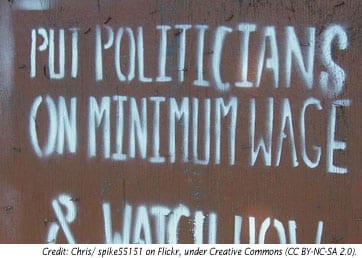
 (WOMENSENEWS)–Have you ever thought about what it would be like to raise your family on minimum wage?
(WOMENSENEWS)–Have you ever thought about what it would be like to raise your family on minimum wage?
The short answer is it would be hard and probably impossible without some form of public assistance despite your long, tiring hours.
The federal minimum wage is $7.25 an hour, or less than $14,000 a year for a full-time worker, which falls below the federal poverty line for a family of two or more. This breaks down to about $270 a week, before taxes, to pay for all of the bills and expenses a family faces.
These are important numbers to keep in mind because many Americans may link minimum wage to jobs performed by teenagers for extra spending money. But that’s far from the reality.
Few minimum-wage workers are in their teens. Eighty percent are 20 years or older, and most minimum-wage earners contribute more than half (54 percent) of his or her family’s weekly income.
Minimum-wage earners are breadwinners–disproportionately female–who are supporting spouses, children, parents and other relatives. While women make up just under half of the national work force, we are roughly 60 percent of minimum-wage workers.
With the worst recession in a generation gripping our nation, more families than ever are relying on minimum-wage jobs in industries such as retail, home health care and food preparation and service. Oftentimes, these are the only jobs available to people trying desperately to keep their families afloat.
Not Enough
 In Illinois, where Women Employed is located, our minimum wage is a dollar more than the federal standard, but working full time, that still translates to $15,840 a year.
In Illinois, where Women Employed is located, our minimum wage is a dollar more than the federal standard, but working full time, that still translates to $15,840 a year.
That’s not enough.
A single parent in Illinois with a pre-schooler and a school-age child would need approximately $50,000 a year to cover the basics of housing, food, health care, transportation and child care without government support.
That would be a real living wage and it would be more than three times what a minimum wage worker would earn.
Rachel Readus can attest to how hard it is to survive on the minimum wage in Illinois. When she was still in high school, her mother passed away and she had to support herself. Even as a single woman without children, living on minimum wage was a struggle.
"I was working in retail jobs for minimum wage and I had to pay my own bills — rent, utilities, food, the whole nine yards. I was working until 1 or 2 in the morning, and then I’d have to be back at work at 8 a.m. the next day, but I still wasn’t earning enough to get by," she told me. "Most of the time, I couldn’t afford to pay my rent. I would live in an apartment for three or four months until I couldn’t afford the rent anymore, and then I’d move from place to place, sleeping at friends’ houses. I just could never earn enough to get by."
We can do better for people like Rachel, and we have done better in the past.
Lagging Behind Inflation
 The minimum wage has not kept up with inflation. If it had kept up with the purchasing power it had in 1968, the Bureau of Labor Statistics estimates that today it would be $10.39 an hour, about $20,000 a year. A recent poll shows that 67 percent of Americans support gradually raising the minimum wage to that level.
The minimum wage has not kept up with inflation. If it had kept up with the purchasing power it had in 1968, the Bureau of Labor Statistics estimates that today it would be $10.39 an hour, about $20,000 a year. A recent poll shows that 67 percent of Americans support gradually raising the minimum wage to that level.
Some argue against the minimum wage as a job killer to be avoided in the current prolonged period of high unemployment. But extensive research does not support that argument. Raising wages reduces costly turnover and increases productivity because workers who are paid more stay with their employer longer.
The first minimum wage was passed in 1938, during the Great Depression, as a way to help America’s workers and increase consumer purchasing power to stimulate the economy.
It worked then, and it can work today. Raising the minimum wage should be a key strategy for our economic recovery, because more money in the pockets of low-income consumers means more spending on local businesses, which raises profits and revenues and leads to hiring.
Wages paid for hard, important work should at least allow a worker to feed and clothe their families, keep a roof over their heads and pay for transportation and child care.
We can make it happen. There are movements in states around the country to raise the minimum wage. In Illinois, for example, the Raise Illinois coalition is working to increase the minimum wage to $10.65 an hour; and you can take action on its website.
If you live in another state, look for a similar movement in your area and get involved. And call your federal senators and representatives today and urge them to support a higher minimum wage.
Let’s make the minimum wage a living wage.
Would you like to Comment but not sure how? Visit our help page at https://womensenews.org/help-making-comments-womens-enews-stories.
Would you like to Send Along a Link of This Story?
Melissa Josephs, a longtime activist for fair workplaces, is director of equal opportunity policy at Women Employed, a 39-year-old organization that mobilizes people and organizations to expand educational and employment opportunities for America’s working women. Women Employed is working to make the minimum wage a living wage in Illinois as part of the Raise Illinois coalition.


